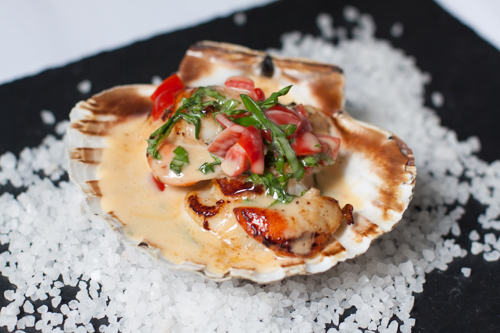Dad's scallops with beurre blanc
 Friday, September 14, 2018 at 10:41AM
Friday, September 14, 2018 at 10:41AM 
This recipe is a family favourite. When we go back to Australia for Christmas, this is always on the list of things that my sister and I ask my Dad to cook. Despite the fact that I have known how to make it for years, there is something special about Dad making it for us at this time of year, because it has always been on the menu on Christmas Day.
Beurre blanc is one of my favourite sauces – delicious, elegant and decadent. Traditionally, beurre blanc is an emulsion in which butter is carefully whisked into a white wine reduction at a low temperature so that it doesn’t split. However, to avoid the fuss of both getting the emulsion right and then having to keep it at the correct temperature, my Dad adds a little cream, which stabilises it. The consistency is a bit different from a traditional beurre blanc, but it tastes amazing and it’s much easier.

My Dad makes his beurre blanc with champagne, tomato and basil. We usually serve it with scallops, but it is fabulous with any seafood or chicken. Dill and chives also work well with seafood and tarragon is a good option with chicken. You can use white wine if you prefer and tomatoes are optional. If making ahead of time, I suggest leaving the tomatoes and herbs out and adding them later when you reheat the sauce.
We serve the scallops in their shells, either as a canape or starter, with lashings of sauce. Sometimes, if Dad is feeling extra generous, he makes a bed of crispy fried potato straws for the scallops to sit on. He does this by julienning the potato, drying out and then shallow or deep frying. I usually skip this step, but it does add wonderful texture.
Makes enough for 12 canapes or 4 starters.

Ingredients
For the beurre blanc
200ml champagne, dry sparkling or dry white wine
1 shallot, peeled and roughly quartered
1 clove garlic, peeled and cut in half
Pinch of peppercorns
Small bunch basil
1 large ripe tomato or 1 handful cherry tomatoes
100ml cream
50g butter
Salt and freshly ground black pepper, to taste
For the scallops
1 tbsp of butter or olive oil
12 scallops
Pinch Maldon sea salt
Method
To make the beurre blanc, put the wine, shallot, garlic, peppercorns and a few sprigs of basil in a small saucepan over a low heat and simmer for about 10 minutes, until it is reduced to roughly 1 or 2 tablespoons of liquid.


Meanwhile, dice the tomatoes and finely chop the remaining basil leaves. To avoid bruising the leaves, I do this by stacking roughly 10-20 leaves on top of each other, rolling into a cigar shape and finely slicing them. Put to one side.
Place a sieve over a medium-sized saucepan and pour the wine reduction through it. Use the back of a spoon to gently press the aromatics to ensure you have all the juice. Discard the aromatics.
Place the reduction over a low heat and pour in the cream, whisking as you do so. Add the butter and continue whisking. It should thicken slightly at this point, but it doesn’t matter if not, it will still taste great.
Add the tomatoes, stir for 30 seconds and remove from the heat. Finally, stir in the basil.
To cook the scallops, heat the butter or oil in a frying pan over a medium to high heat. Season the scallops with a little sea salt. Sear the scallops on each side then cook for 1-2 minutes on each side, depending how rare you like them.
Arrange the scallops in the shells (1 per person for canapés, 3 per person for starters) and spoon over the sauce. Serve immediately.


Reader Comments (2)
SPRING IS HERE in Sydney, but the basil hasn't come through yet. When it does I'd like to give this a go, you make it sound so simple. But then again, I could just ask Dad to make it for me. Or if you get back for Christmas you can !Here's hoping ! xxx
Hi Ma, yes it is very easy. Last time I asked Dad to make them he accidentally made hollindaise. Might be better left in your safe hands ;-)